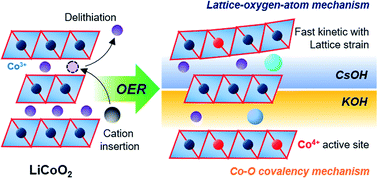Alteration of oxygen evolution mechanisms in layered LiCoO2 structures by intercalation of alkali metal ions†
Abstract
Two oxygen evolution reaction (OER) mechanisms on layered lithium cobalt oxide (LiCoO2 and simply LCO) were demonstrated by inserting various alkali metal ions. During the OER, we observed the insertion of large cations (Na+, K+, and Cs+) into delithiated LCO from the corresponding electrolyte solutions. The deep intercalation of hydrated Na+ and K+ resulted in significant structural transformations of delithiated LCO. In addition, the intercalated cations and remaining Li+ determined the average Co valence states in the LCO catalysts. Characteristic analyses showed that the increased Co valence state and Co–O covalency enhanced OER activity (LiOH < NaOH < KOH). In addition, density functional theory (DFT) calculations supported the formation of OER active sites as K+ was partially intercalated. In contrast, the superior OER activity obtained after Cs+ insertion entailed a different process. A sharp rise in the OER activity at a high pH and bent edges of oxide layers imposing surface tensile strain supported the lattice-oxygen-mediated OER. The original LCO bulk structure is mostly preserved with Cs+ insertion, offering better catalytic stability.



 Please wait while we load your content...
Please wait while we load your content...